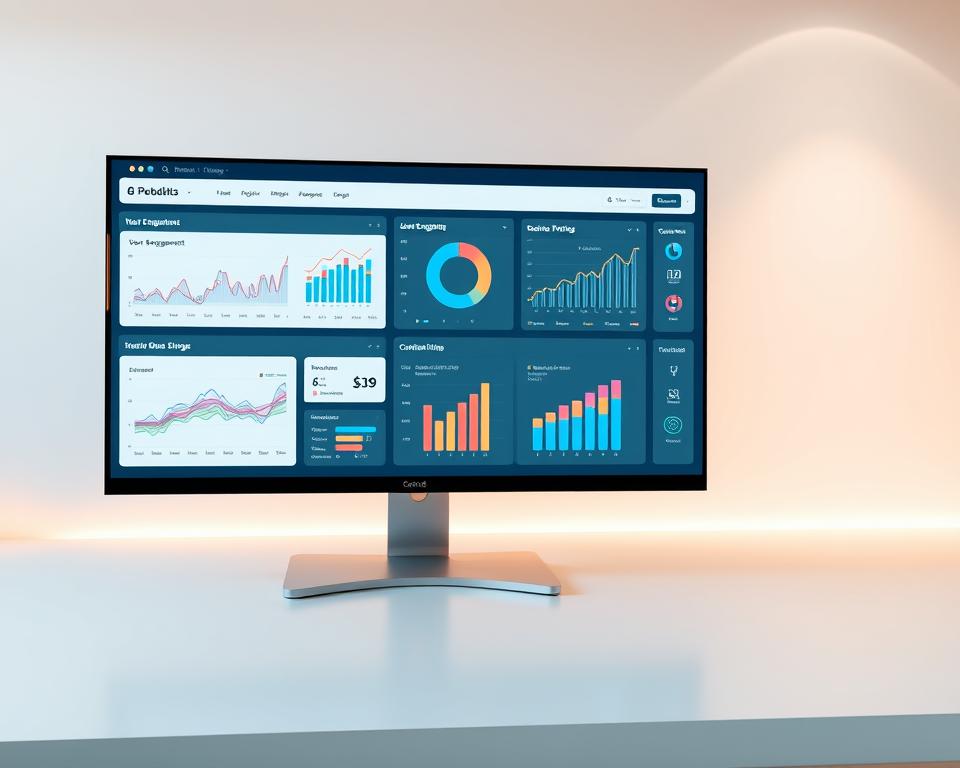Anúncios
Want to know which metrics really move the needle for your business? This practical, up-to-date Analytics Guide starts with clear steps so you can turn raw data into smarter decisions.
You’ll get a simple path through core concepts and current trends. We focus on what works now, from GA4 behavior flows to linking Google Ads and Search Console for richer acquisition context.
Expect hands-on examples to connect website, social media, and customer feedback. We highlight where automation and AI can speed insight, and where testing and measurement keep your work honest.
This section sets expectations: no one-size-fits-all rules, just actionable options you can pilot, measure, and adapt to your audience and goals.
What “Analytics” Means in 2025: Data, Digital, and Web
Start by separating big-picture business data from the signals you track on products and sites.
Anúncios
Data analytics covers any business information — financial, operational, or customer records — used to answer broad questions about performance and cost. It helps you link outcomes to investments and risks.
Digital analytics looks across apps, email, social, and product touchpoints. It captures behavior from multiple channels so you see how people move between media and your website.
Web analytics is narrower: it focuses on website traffic, page behavior, load times, and conversion events. Use it when the site is the primary channel for acquisition or service.
Anúncios
“Combine qualitative signals like interviews with quantitative event data to learn both what users do and why.”
How teams use these sources:
- Product managers watch feature usage and retention to prioritize work.
- Marketers read acquisition and campaign reports to tune content and ads.
- UX designers use heatmaps and session replays to solve usability pain points.
Centralized platforms and AI make this easier by giving non-specialists direct access to insights. But be careful: don’t generalize website-only findings to cross-channel strategy. Define success the same way across teams so metrics roll up to business outcomes.
Building Your 2025 Analytics Strategy
Start your strategy by tying measurable goals directly to business outcomes. Keep the plan tight: name outcomes, pick a few metrics that show progress, and map where each signal will come from.
Set goals and success metrics tied to business outcomes
Write specific goals that reflect business value. Then define success metrics you can track over time. Convert those goals into events and properties so your queries stay consistent.
Map sources: website, app, social, ads, CRM, VoC
List the core sources of data and assign ownership. Knowing where each signal lives helps the team trust reports and make faster decisions.
Create an experimentation and measurement plan
Use a lightweight process: form a hypothesis, name the metric, run the test, and capture results for management review.
“Prioritize high-impact pages and journeys first; small wins build credibility.”
- Connect ad and search accounts to see acquisition quality vs on-site behavior.
- Create practical audiences (high-intent, cart starters) for targeted follow-ups.
- Set a review cadence so fresh signals drive decisions, not stale snapshots.
Core Metrics That Matter: Engagement, Performance, and Conversions
Focus on a few reliable metrics that reveal whether your site keeps visitors engaged and moving toward goals. These signals help you spot what to fix first and what to test next.
Engagement signals
Track pages per session, session duration, and key events to see if your content holds attention. Use behavior reports to find top pages, events, and exits.
Behavior Flow shows common paths and where people drop off. Use that to prioritize pages that lead to deeper exploration.
Performance indicators
Monitor site speed, error rates, and drop-offs. Slow pages or frequent errors reduce engagement and hurt conversions.
Site Speed reports include practical suggestions you can test. Fixing load time often raises event completions and session depth.
Conversion clarity
Define primary goals and micro-conversions so progress is measurable. Don’t assume causation from correlation—use tests to prove changes work.
Check assisted conversions to value channels that help earlier in the journey. Attribution views give context but rarely tell the whole story.
- Use engagement metrics to judge content relevance for each audience and page type.
- Track performance to find technical blockers that lower satisfaction.
- Define conversions broadly and test tweaks before scaling.
“Small, focused tests turn metric changes into reliable improvements.”
Web Analytics Foundations with GA4
Start with practical steps to connect site behavior and acquisition so you can act fast. Linking product accounts and defining events turns raw data into decisions you can use.
Linking Google Ads and Search Console for richer insights
Use Admin > Product Linking to connect Google Ads and Search Console. Search Console needs site verification with the same email.
Events, conversions, and audience definitions in practice
Define events that match your real goals. Mark key events as conversions so reports show business impact.
Create audiences (recent visitors, goal completers, page viewers) for remarketing and analysis.
Behavior and user flow visualization to spot drop-offs
Open Behavior Flow to see session paths and high-exit pages. Redesign those steps to reduce friction.
Site speed insights and actionable optimization suggestions
Check Site Speed > Speed Suggestions monthly. Fixing load issues often improves engagement and conversions.
- Link campaigns to on-site behavior so you fund quality visits, not just clicks.
- Share simple dashboards that show website health and conversion paths.
- Keep permissions tidy for better user management and decision speed.
“Treat GA4 as one tool in your stack; combine it with qualitative research and experience tools when needed.”
Digital Experience Analytics: Heatmaps, Replays, and Journeys
Experience tools reveal which page elements grab attention and which confuse customers.
Heatmaps show where users click, scroll, and linger on a website. Use them to refine layout and content hierarchy so the most important features get noticed.
Session replays let you watch real behavior. You’ll spot hesitation, rage clicks, and form struggles that raw data can’t explain. Compare replays across segments to build pages that match customer intent.
Journey analysis to cut friction
Map common paths to find high-impact routes and dead ends. Prioritize pages with strong engagement but low completion—these are often quick wins.
- Use AI summaries to surface patterns and save time.
- Document hypotheses and test changes incrementally.
- Coordinate with product and engineering to turn insights into tickets.
Be transparent: disclose recording policies and mask sensitive fields to protect privacy.
Track before/after metrics to confirm you improved the customer experience over time.
Social Media Analytics in 2025: Tracking Impact Beyond Vanity Metrics
Focus on the posts that send quality visitors to your site, then measure what those visitors do. Social media can drive awareness, but you need to see whether those visits turn into action.
Channel reporting: reach, engagement, click-through, conversions
Build channel reports that compare networks across the funnel. Combine reach and engagement with click-through rates and on-site conversions to get a fuller picture.
Use consistent campaign tagging so you can attribute outcomes back to themes and formats. In GA, check Social > Overview to see last interaction versus contributed social conversions and map those to site behavior.
Campaign learnings to inform content and paid strategy
Translate social data into your content calendar and paid plans. Track which creative leads to deeper engagement and which formats produce quality visits.
- Compare last interaction with assisted conversions to understand social’s role.
- Monitor audience trends so your creative stays relevant.
- Share concise reports that show what to scale and what to stop.
“Measure what moves the journey, not just the moment.”
Voice of Customer and Qualitative Insights
Capture real customer voices to turn vague numbers into clear next steps. Qualitative work complements your quantitative data by revealing intent, emotion, and the words people use.
On-site surveys to capture intent and barriers
Launch targeted on-site surveys at key moments like checkout or form completion. Keep them short and focused so people answer.
Use open-ended prompts to collect phrases you can reuse in content and UI copy. Record consent and anonymize responses.
User interviews and prototype testing for deeper context
Schedule brief interviews with customers and ideal prospects to probe unmet needs. Run remote prototype tests to watch how people navigate flows.
Transcribe and use AI summaries from experience platforms to speed analysis. Link qualitative feedback to behavioral data to confirm whether what people say matches what they do.
“Prioritize fixes that deliver the most value, start small, and measure the impact.”
- Map findings to behavioral reports to create clear action items.
- Close the loop: update content, help docs, or UI copy using customer language.
- Respect consent, minimize stored details, and treat VoC as ongoing work.
AI and Automation in Analytics Workflows
AI and automation speed routine monitoring so your team can focus on high-impact work.
Set up AI alerts for your critical KPIs so you hear about anomalies quickly. Systems can flag conversion rate dips, bounce spikes, error rises, or odd segment behavior and notify you via email or Slack.
Frustration scoring turns messy signals into a simple 0–100 score. It factors rage clicks, form resubmits, JS/API errors, and slow pages. Use that score to prioritize fixes that will likely move the needle on performance and results.
Automatic data capture reduces manual tagging and gives retroactive coverage when goals change. That shortens setup time and records interactions you might otherwise miss.
Combine machine summaries with human review. AI helps surface trends and saves time, but your judgment should confirm causes before shipping changes.
- Filter replays by frustration to verify issues.
- Align alert thresholds with launches and promos.
- Share prioritized backlogs with product and engineering for fast management.
“Treat automation as a support system that helps analytics help everyone act faster and smarter.”
analytics guide 2025: Tools, Platforms, and Features to Consider
Pick tools that help you connect site behavior, product events, and social signals so teams can act on full journeys. A good platform reduces blind spots and makes collaboration faster.
Neutral evaluation means you avoid hunting for a single best vendor. Instead, compare how each platform fits your workflows, data sources, and privacy rules.
Connected stacks: integrating web, product, and social
Look for platforms that integrate web, product, and social analytics so you can trace journeys end to end. Confirm integrations with your core sources and that identity and consent workflows meet your standards.
Evaluating features: reporting, dashboards, collaboration
Evaluate analytics tools on reporting flexibility, dashboard clarity, access controls, and collaboration features. Prioritize automatic data capture and retroactive coverage to cut maintenance.
- Assess AI for alerts, summaries, and prioritization, but require transparency about methods and limits.
- Pair VoC and behavior so you act on both what users do and why they do it.
- Validate activation — the platform should play well with your website stack and downstream destinations.
- Consider people — vendor support, timelines, and how quickly companies like yours realize value.
“Pilot with a small team and a focused use case before expanding; build a comparison matrix to match features to your business and customer needs.”
Governance, Privacy, and Compliance Considerations
Design data collection so it respects user choices and stays useful for business decisions. Start from consent and minimization to keep trust high while preserving necessary signals for reporting.
Respecting consent and data minimization
Collect only what you need. Honor consent consistently across tags, replays, and integrations. Mask or omit sensitive fields in session captures.
Document retention, access, and deletion processes so governance is repeatable. Train people on acceptable use and the purpose of each dataset.
Mitigating signal loss with ethical, privacy-safe methods
Expect some signal loss from platform and OS changes. Use first-party measurement and offline conversion uploads to reconcile outcomes without overtracking.
Coordinate with marketing to align campaign tags and consent state so attribution mirrors user choices. Include compliance checks in feature launches and review vendor contracts to protect your company and users.
“Balance insight with user trust—good decisions come from ethical practices that scale.”
- Limit raw-data access and audit who can export records.
- Keep up with privacy trends and update your process accordingly.
- Make governance part of product and marketing workflows, not a separate task.
Reporting That Drives Action
Design reports that help people make fast, confident decisions, not just admire charts. Start by tailoring dashboards to who will use them and what choices they must make.
Audience-first dashboards for executives and practitioners
For executives, show a few core KPIs tied to business outcomes. Include trend context, a short note on impact, and one recommended action.
For practitioners, provide journey-level views: content paths, Behavior Flow, and site speed signals so they can fix issues fast.
Storytelling with assisted conversions and journey insights
Use GA’s Conversions reporting to highlight assisted conversions and explain multi-touch roles. That helps you credit channels that move prospects early in the funnel.
“Show what changed, what you learned, and the next experiment or fix.”
- Keep reports tight: include just enough data to support the narrative and link to deeper reports for detail.
- Combine signals: pair journey insights with site speed to show how performance drove conversion uplift.
- Annotate: mark test launches or incidents so trends are easy to interpret.
Close each report with a clear decision: who acts, by when, and how success will be measured. Use an example where a small content tweak raised engagement and later conversions to make the case practical.
For templates and operational framing, see a short primer on improving reporting and sales performance at sales reporting and analytics.
Real-World Examples and Common Pitfalls
Real examples show how small, focused changes can lift engagement without massive rebuilds.

From high bounce to higher engagement: start with Behavior Flow and Site Speed reports. Find pages with high exits that also load slowly. Fix images, defer scripts, and reduce server time in a single step.
Then run a brief A/B test. Measure engagement and conversion before you change content. This helps separate content issues from performance problems so you fix the right thing first.
Attribution misunderstandings and how to avoid them
Campaigns that look weak on last-click often appear valuable when you check assisted conversions and journey context. Don’t over-credit the final touch.
- Use multi-touch views to see how channels nurture users.
- Simplify forms to reduce errors — fewer fields often raise completion rates.
- Set clear goals before testing so you know what result counts.
“Ask why changes worked and document the steps so teams learn faster and repeat success.”
For a collection of practical case studies and example results, see this short case study examples.
Conclusion
End with an invitation to pilot small changes, measure results, and scale what delivers value.
Combine GA foundations (events, audiences, Behavior Flow, Site Speed, assisted conversions) with experience tools like heatmaps, replays, and VoC to get fast, useful insights.
Keep your strategy practical: set clear goals, pick a few metrics, and use platforms and tools that fit your team and processes.
Test on a small scale, measure carefully, and apply human judgment to AI summaries so you prioritize fixes that help customers and the business.
Be privacy-aware, treat attribution as guidance, and make reviews a habit. Start small, learn quickly, and adapt your approach to your website, audience, and goals.


